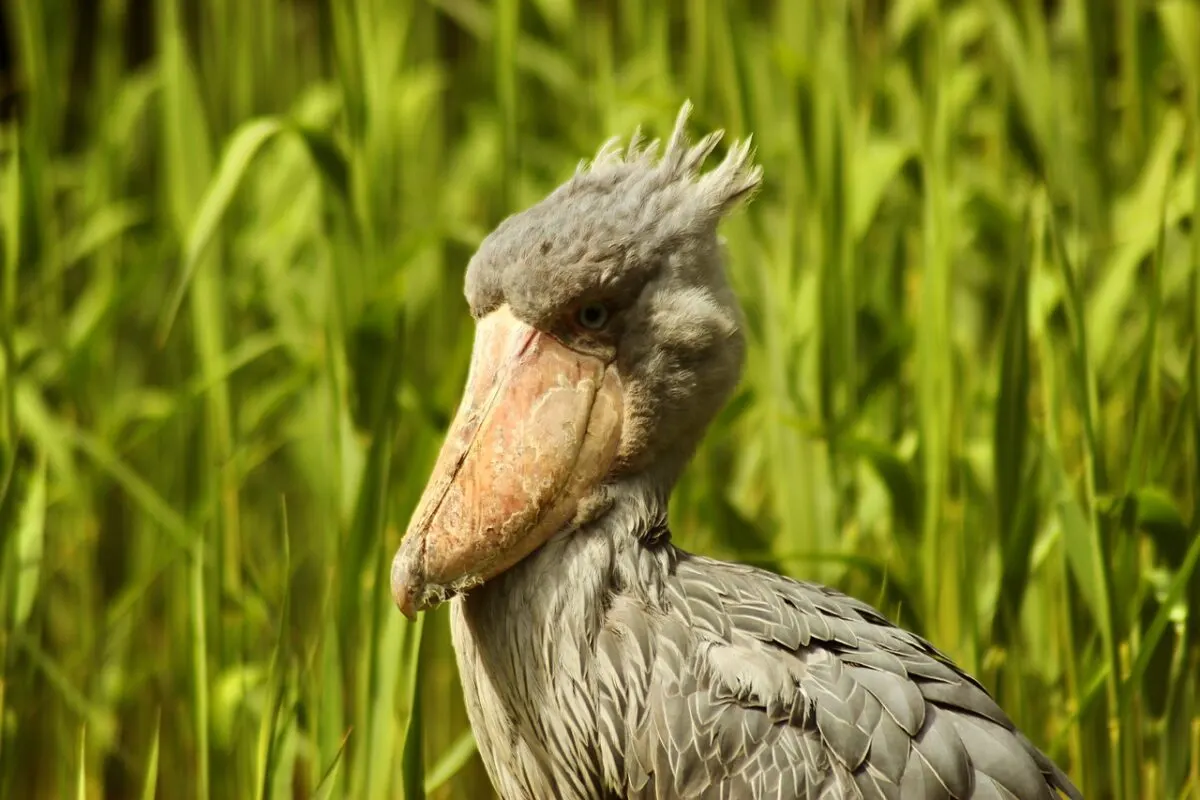Welcome to Shoebill Stork vs Crocodile. A comparison of two unequal competitors. My favorite is the Shoebill Stork, but let’s see how the two compare!
Let’s delve into an intriguing hypothetical face-off between two creatures – the Shoebill Stork and the Crocodile. While human encounters with these creatures are rare, understanding their behaviors and capabilities helps us appreciate their role in the ecosystem and our place.
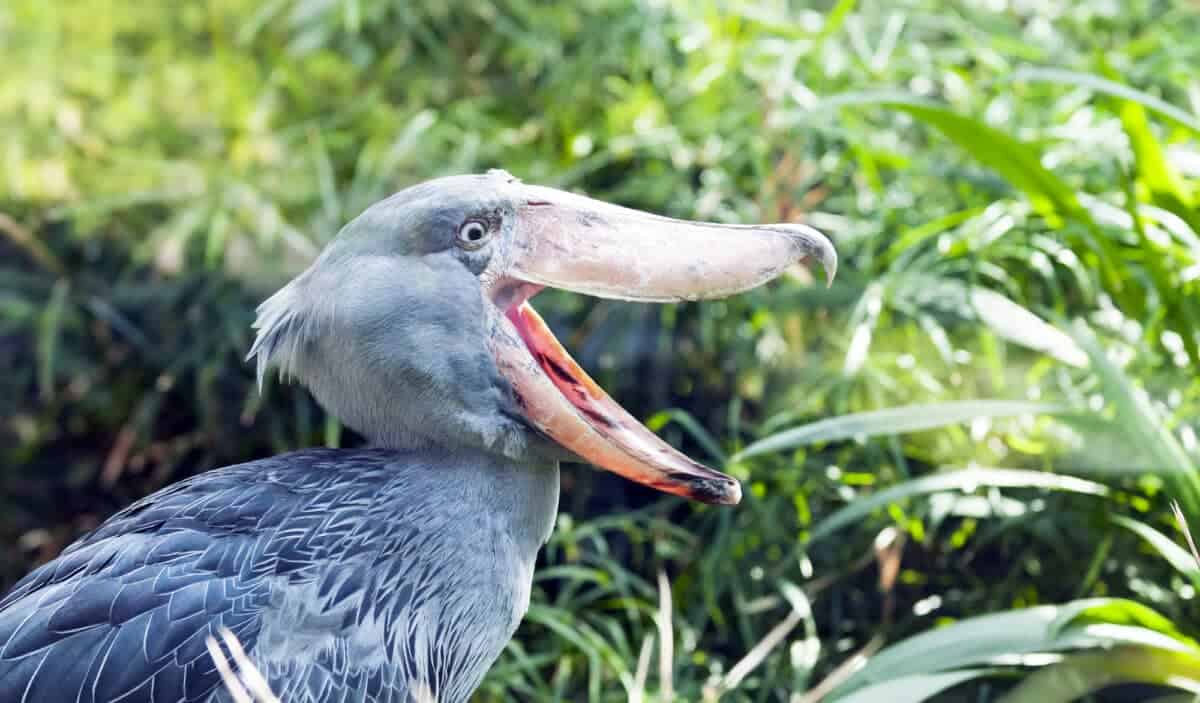
Read the entire article or jump to any section.
The Majestic Shoebill Stork
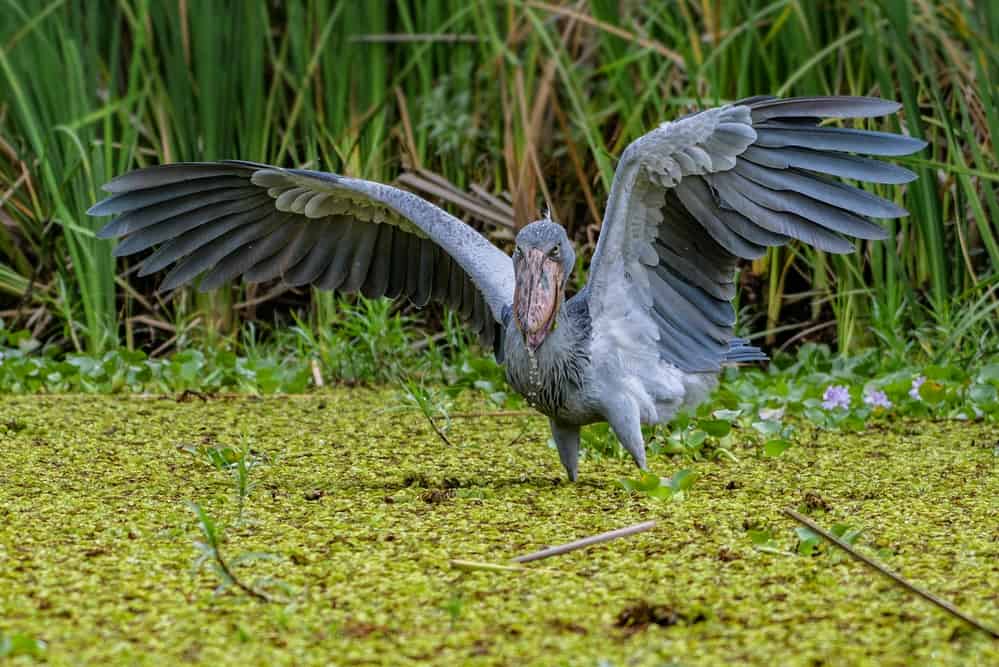
- Class: Aves (Birds)
- Size: Height of up to 5 feet, with a wingspan of over 8 feet
- Weight: Typically between 4 to 7 kg (8.8 to 15.4 lbs)
- Bite Force: Not formally measured, but strong enough to catch and kill large lungfish and monitor lizards
- Location: Predominantly found in Eastern Africa
- Habitat: Prefers freshwater swamps and marshes
The Shoebill Stork, a bird native to the tropical swamps of East Africa, is a sight to behold. Standing as tall as 5 feet with a wingspan of over 8 feet, it possesses an imposing presence. This bird’s most distinctive feature is its shoe-shaped bill, used to catch its prey, mainly comprising fish and amphibians.
The Shoebill is a solitary creature, noted for its statue-like stillness when hunting. It can wait patiently for hours, using its incredible vision and hearing to detect movement. Once it spots prey, it strikes with lightning speed and precision. Despite its size, the Shoebill is surprisingly quick, capable of brief bursts of speed up to 30 mph.
However, this stork is not a threat to humans unless provoked. It is, in fact, endearing, exhibiting unique behaviors like bill-clattering, which resonate with a sense of power and courage.
The Fearsome Crocodile
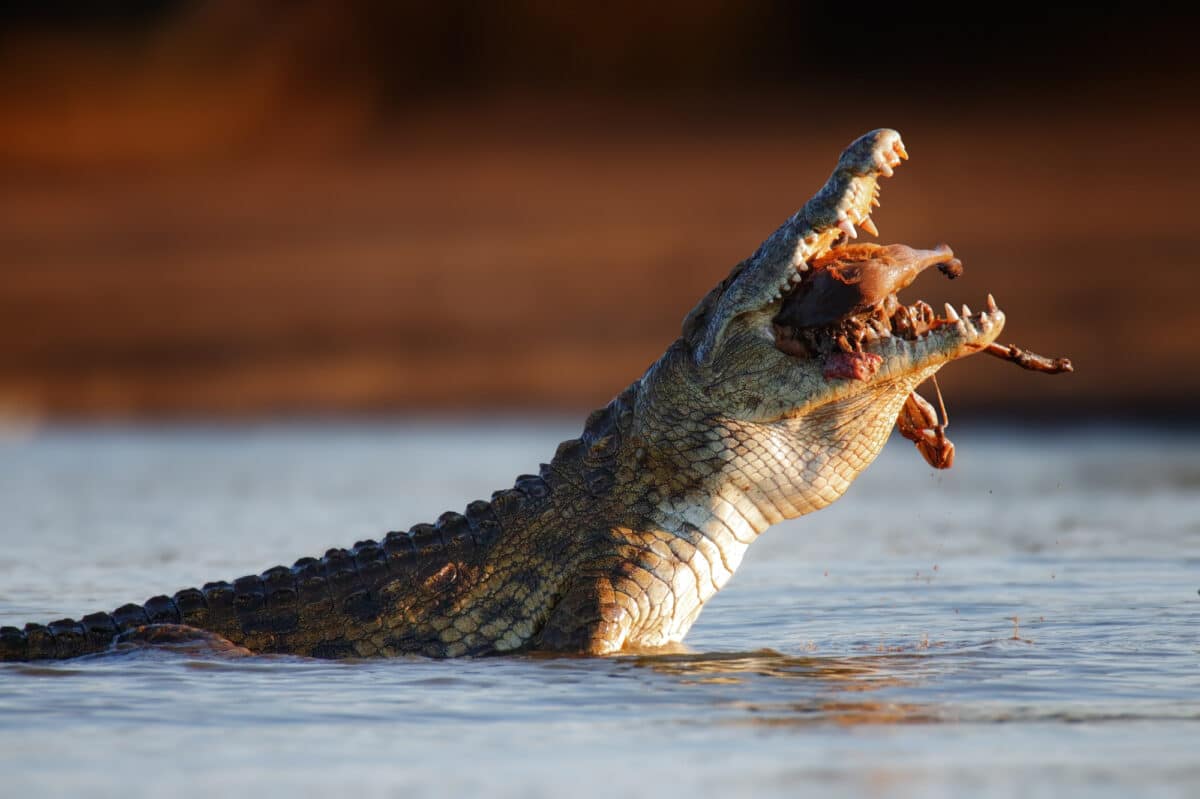
- Class: Reptilia (Reptiles)
- Size: Can reach lengths of up to 20 feet, depending on the species
- Weight: Varies greatly with species, Nile crocodiles can weigh up to 730 kg (1600 lbs)
- Bite Force: One of the strongest in the animal kingdom, nearly 3,700 PSI for the saltwater crocodile
- Location: Found worldwide, primarily in tropical regions
- Habitat: Lives in freshwater habitats like rivers and lakes, as well as brackish water environments.
Crocodiles, found in tropical regions worldwide, are renowned for their strength and resilience. A large crocodile can reach up to 20 feet in length and weigh over 2000 pounds. Its thick armored skin and powerful tail are formidable defensive and offensive tools.
You might also like to learn about Giant Crocodile ‘Dominator’ That Leaps from the Water.
Crocodiles are apex predators, using stealth and patience as their hunting strategies. They possess a deadly bite force, estimated at 3700 pounds per square inch – the strongest among living animals. Their cognitive abilities are also impressive, with studies showing they can learn tasks and remember them for years.
Although crocodiles are feared by humans due to their aggressive behavior and powerful bite, they generally avoid human contact unless threatened or during breeding season.
Key Factors between Shoebill Stork and Crocodile
Appearance
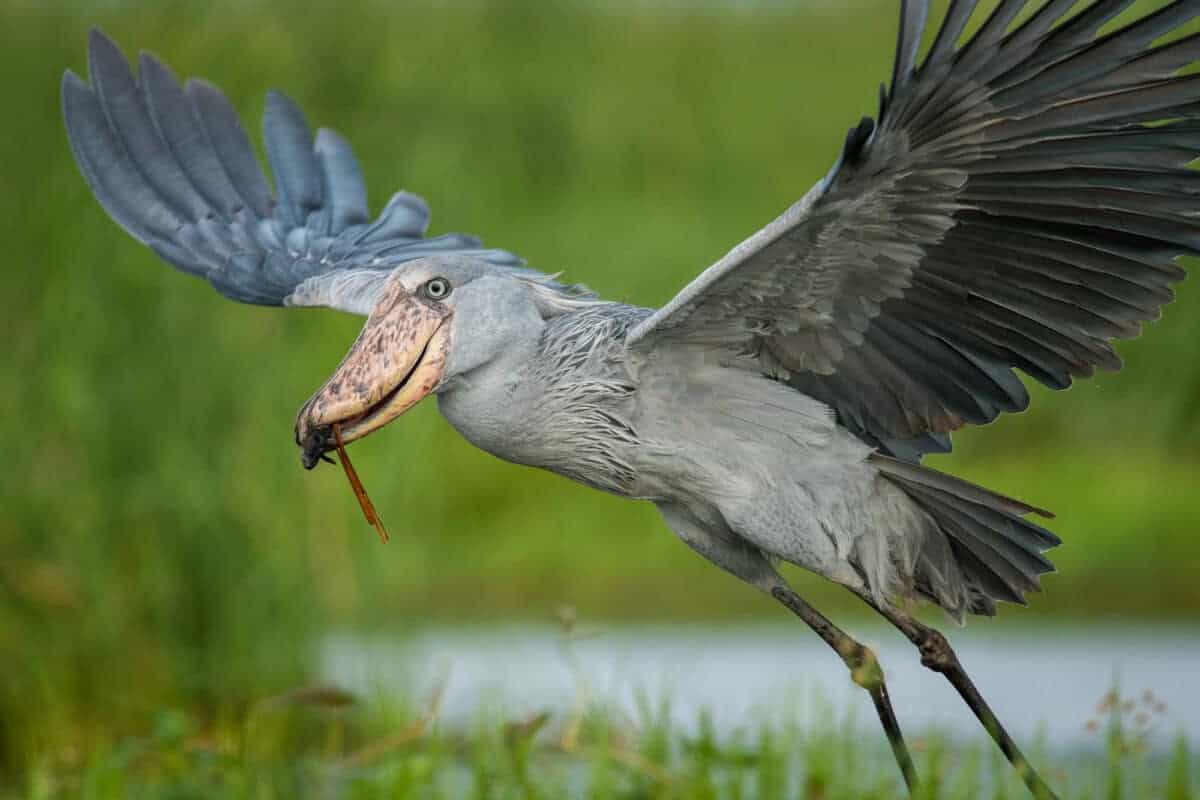
The crocodile is a creature that demands respect and fear. Its body is a testament to millions of years of evolution, perfectly adapted for life as an apex predator. Its elongated body, covered in thick, armored scales, is equipped with one of the animal kingdom’s most powerful jaws. It has a long, muscular tail used for swimming, and its eyes, ears, and nostrils are located on the top of its head, allowing it to remain almost completely submerged while stalking prey.
The shoebill stork’s appearance is striking and unmistakable. Its large shoe-shaped bill, which gives the bird its name, is a powerful tool crafted for capturing and killing prey. The bird’s overall color is a slate grey, and its long legs and broad wings give it a formidable presence in its marshy habitats.
You might also like: Gorilla vs. Brown Bear: Who would win in a fight?
Diet
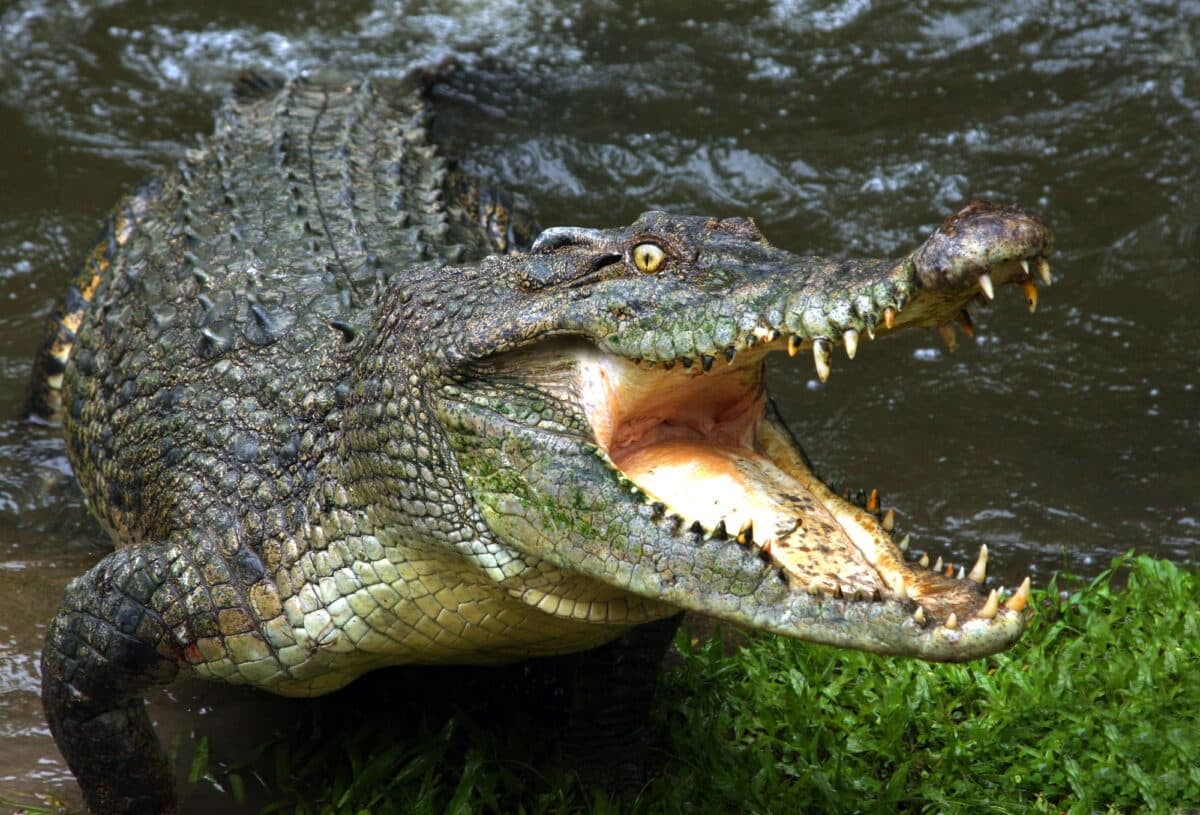
The diet of the shoebill stork primarily consists of fish, but it’s also known to consume amphibians, small reptiles, and even small mammals. The bird uses a hunting strategy known as ‘stand-and-wait’, showcasing its patience as it remains still for long periods before striking with lightning speed to catch unsuspecting prey.
Crocodiles have a broad diet, making them opportunistic predators. They are known to eat fish, birds, and larger mammals, using their powerful jaws to grab and hold onto their prey before drowning or crushing it.
Geographical Location
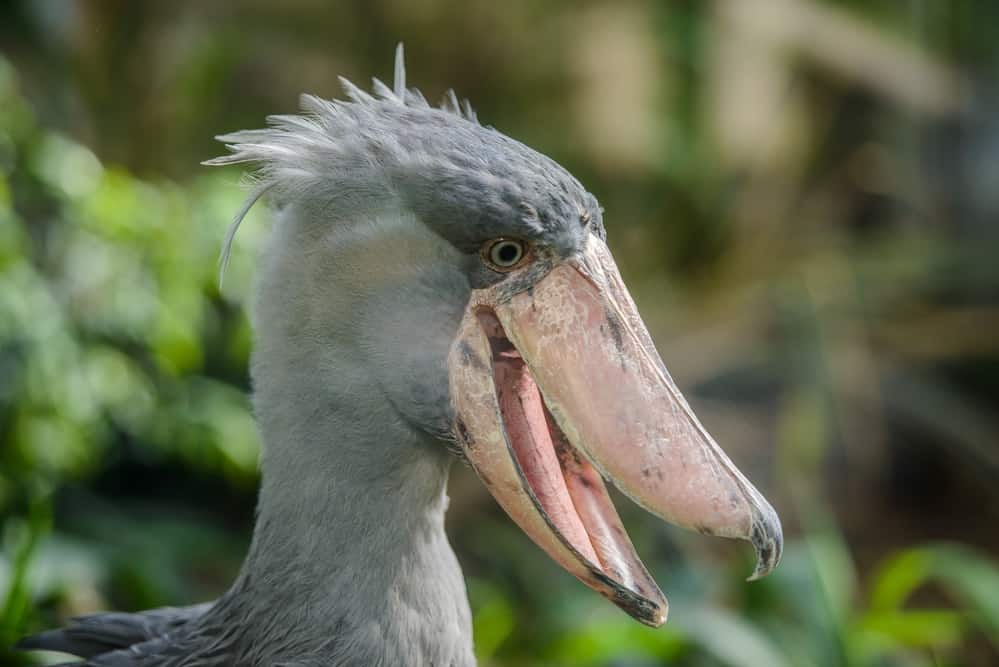
Geographically, crocodiles are found primarily in tropical regions around the world. From the Nile crocodile in Africa to the Saltwater crocodile in Australia and Southeast Asia, they inhabit a wide range of freshwater and brackish environments.
These animals, though vastly different, share a common tenacity for survival, perfectly adapted to their unique environments. Their striking appearances, specialized diets, and widespread geographical distributions make them fascinating subjects of study and admiration.
The shoebill stork is predominantly found in the marshes of Eastern Africa. Countries such as South Sudan, Uganda, and Zambia are known to house these magnificent birds.
The Hypothetical Face-off
| Attributes | Shoebill Stork | Crocodile |
|---|---|---|
| Habitat | Eastern Africa’s Marshes | Tropical Freshwater & Brackish Environments |
| Diet | Fish, Amphibians, Small Reptiles | Fish, Birds, Larger Mammals |
| Body Length | Up to 5 Feet | Up to 20 Feet |
| Speed | Not Notable | Up to 20 mph in water |
| Bite Force | Not Formally Measured | 3700 PSI |
| Cognitive Abilities | High Patience, Quick Reflexes | High Intelligence, Strategic Hunting |
| Sensory Mechanisms | Excellent Sight | Advanced Sensory Mechanisms |
| Aggressive Capabilities | Defensive | Highly Aggressive |
| Hunting Strategies | Stand-and-Wait | Ambush Predator |
| Threat to Humans | Low | High (when encroached upon) |
A confrontation between these creatures would be a battle of patience and strategy. The Shoebill, using its superior height, might attempt to strike from above, aiming for the crocodile’s vulnerable eyes. The crocodile, on the other hand, would rely on its stealth and powerful bite.
Yet, in nature, such confrontations are rare. Both species primarily focus on smaller, more manageable prey, and a battle between them would be energy-intensive and risky. Furthermore, they coexist in similar habitats, playing their unique roles in maintaining the ecosystem’s balance.
Baby Crocodile vs Shoebill Stork
In a hypothetical confrontation between a baby crocodile and a shoebill stork, the outcome could be quite different from a confrontation involving a full-grown crocodile.
Shoebill storks are formidable predators, particularly adept at hunting in water environments. They have a strong bill and large size compared to many other bird species. They are known to prey upon a variety of aquatic animals, including fish, amphibians, and small reptiles.
A baby crocodile, while still a predator, is much smaller in size and has less developed physical capabilities compared to an adult. They are known to be prey for a variety of larger predators, including large birds.
In this scenario, the shoebill stork might have the upper hand due to its size, strength, and hunting skill. It might use its strong, sharp bill to deliver a forceful strike to the baby crocodile. However, it’s also worth noting that baby crocodiles are not helpless. They have sharp teeth and a strong bite for their size, and their mother is often not far away, providing protection.
This is all speculation, of course. In the wild, interactions between species are complex and can be influenced by a multitude of factors, including the specific individuals involved, the environment, and the circumstances of the encounter.
Frequently Asked Questions on Shoebill Stork vs Crocodile
Shoebill storks are generally not considered friendly in the traditional sense, especially towards other birds, as they are solitary creatures that prefer to live and hunt alone. They are not known for being friendly to humans either. While they usually don’t pose a threat to humans unless threatened or disturbed, they are not the kind of bird that seeks human interaction or companionship.
The shoebill stork is not a dinosaur, but it is a bird, and birds are technically considered the last living group of dinosaurs, known as avian dinosaurs. The shoebill stork’s prehistoric-looking appearance may lend itself to comparisons with dinosaurs, but it’s important to note that while birds evolved from a group of two-legged dinosaurs known as theropods, the ancestors of birds and the shoebill diverged from other dinosaurs millions of years ago.
While the shoebill stork has a powerful bill and can consume a variety of prey, including fish, amphibians, and small reptiles, it is unlikely that it would attempt to eat a crocodile. Only a small or baby crocodile would be enough for a shoebill stork to handle. The shoebill stork’s diet primarily consists of lungfish, eels, catfish, lizards, snakes, and small mammals. So, while they are formidable hunters in their own right, they are not equipped to tackle prey as large and dangerous as a grown crocodile.
The primary differences between an alligator and a crocodile lie in their snout shape and habitat. Alligators have a U-shaped, wider snout while crocodiles have a V-shaped, narrower one. Alligators predominantly dwell in freshwater environments such as ponds, lakes, and swamps, primarily found in China and the southeastern United States. Crocodiles, on the other hand, inhabit a broader range of environments, including freshwater, brackish, and saltwater habitats, and can be found in various parts of the world like Africa, Asia, the Americas, and Australia.
Yes, crocodiles can indeed eat humans. They are known to be man-eaters and have been reported to cause human fatalities. However, it’s important to note that such incidents usually occur when humans enter or disturb their natural habitats.
The largest crocodile ever recorded was a saltwater crocodile named Lolong. He measured 6.17 meters (20 feet 3 inches) in length and weighed 1,075 kilograms (2,370 pounds)1.
Conclusion on Shoebill Stork vs Crocodile
In conclusion, both the shoebill stork and the crocodile are majestic creatures, each playing a vital role in maintaining the delicate balance of their ecosystems. A hypothetical confrontation between them serves to highlight their unique attributes and strengths. While we may speculate, the true outcome of such a confrontation remains a secret known only to the wild.
That’s the beauty of nature – it always keeps us guessing, always keeps us learning. From the power of the crocodile’s jaw to the love in a shoebill’s nest, every moment is a testament to the grandeur of the natural world. So let’s continue exploring, continue respecting, and continue marveling at the splendor of nature, for it has so much more to offer.
We hope you liked to read about Shoebill Stork vs Crocodile. If you liked it, also check out our other Animal Comparison Stories.
Or look at Gorilla versus Lion , Lion versus Tiger or Gorilla versus Crocodile.
- Animals and Wildlife in Colorado - April 24, 2024
- Best Places to see Sloths - April 24, 2024
- Where to See Alligators in the Wild - April 24, 2024

